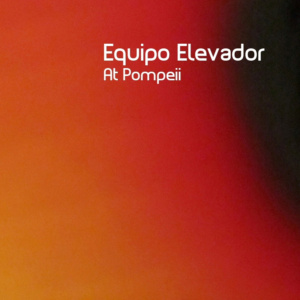
Equipo Elevador At Pompeii, una obra eléctrica para sonidos fijos por Emilio Babirusa
English below translated by Elena B. Peláez
Después de la grabación de este álbum, dejé de ver al Equipo Elevador durante un periodo de tiempo indeterminado. Siendo testigo de la elaboración del proyecto y la evolución del propio Equipo, he de remontarme a la obra ADD (Modisti 13), con una línea de trabajo de cuasi-improvisación que llevaban experimentando desde aproximadamente 2009. Otras piezas como Ranza de 2001 guarda cierto paralelismo involuntario y las ocasionales e interesantes sesiones para directo bajo el nombre de Intervención, realizadas de manera regular y con vistas a puntos de partida, continuaron con un patrón desorientado y sin destino.
La música que suena en At Pompeii es el resultado del trabajo realizado para una Intervención, una intervención que sucedió el 19 de mayo de 2013 en la librería La Libre del Barrio en Leganés, Madrid. Tras semanas de sesiones y periodos de reflexión, construyeron una pieza que se extendía 40 minutos, el tiempo medio de sus obras en directo, hasta esa fecha. Esta Intervención fue grabada en directo con una unidad móvil y entregada al Equipo Elevador; posteriormente en 2020 Thrmnphone, muy acertadamente, publicó el álbum LGNS2013, el disco en directo, hoy descatalogado. Al día siguiente de la Intervención, el Equipo Elevador volvía al estudio, esta vez para registrar la pieza que habían preparado y ejecutado el día anterior, ya que jamás habían realizado ninguna toma previa. Por motivos que ignoramos todos los presentes en ese momento, las muestras que se grabaron en esa sesión de mañana, no coincidían en nada con la intención inicial, es probable que esas largas tomas fuesen ejercicios anteriores a la grabación de la obra o es posible que fuera la siguiente nueva obra del Equipo Elevador…me decanto por la evidencia.
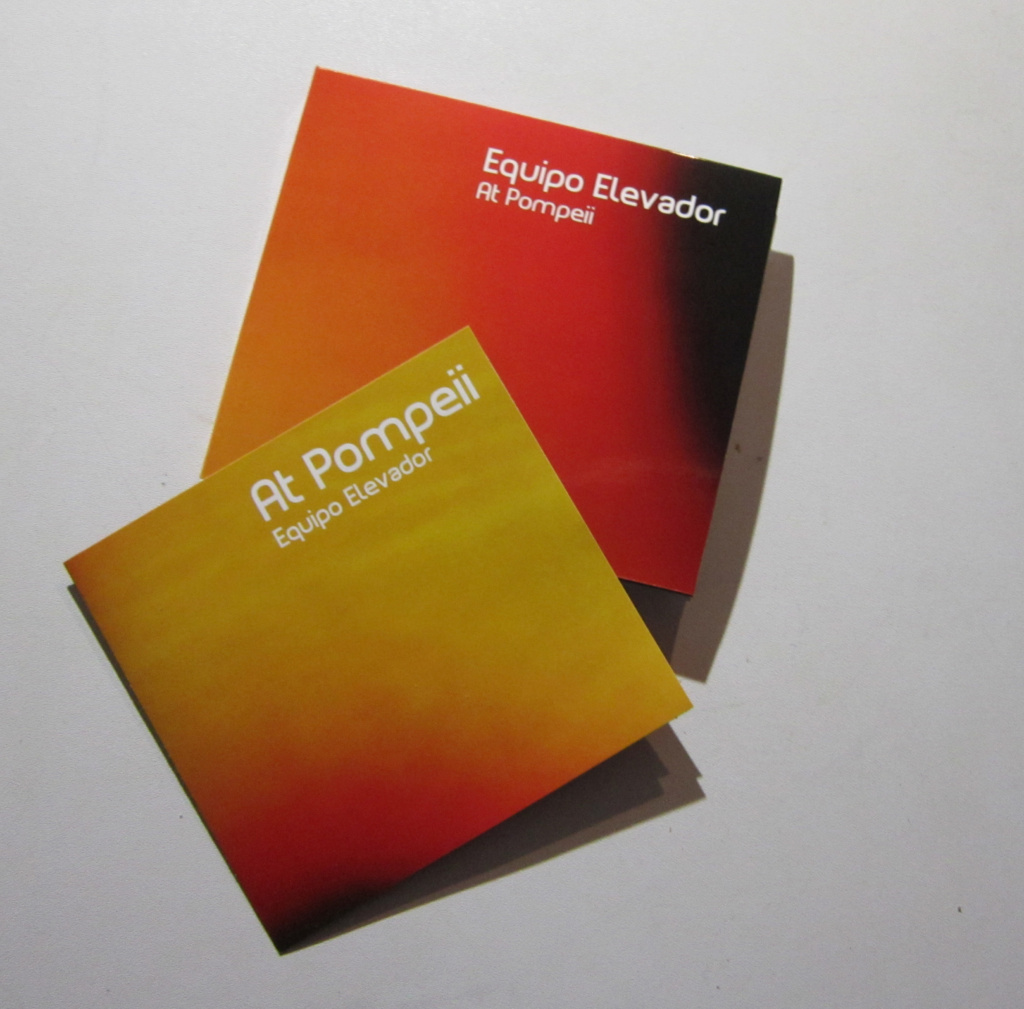
Aquellos no fueron buenos años político-sociales, si es que alguna vez, esas sensaciones se manifiestan en el hacer del Equipo Elevador, pero se nota la tendencia a la agresividad y el extremo de esa época, dejando atrás las obras conceptuales y complejas y su aspiración de llegar a un fin, que era la sutileza; pero todo aquello por lo que convencidos estuvieron trabajando, se vino abajo y no quedó más que aceptar lo que tenían o lo que son, su sonar obsesivo y que ahora, dentro de una situación introspectiva, los sonidos de lo que iba a ser At Pompeii, terminaron por ser abrasivos.
La grabación fue algo caótica por parte de los técnicos que tuvieron que acondicionar el estudio apresuradamente, después del directo. Yo mismo preparé la cinta donde se iba a realizar la grabación y escribí en la etiqueta “Pompeya secreta” (Fundación Autor 2010), un guiño a aquel pequeño estudio musical en midi del Equipo Elevador de 2001, como título provisional, pero sólo un error puede ser la explicación que no se utilizara esa cinta si no otra, rotulada “At Pompeii”, que supuestamente contenía una copia master de “Pink Folyd At Pompeii”, de aquella banda de rock. Según los técnicos, no entienden todavía lo sucedido, siendo esto su responsabilidad. De lo que si hay seguridad, es que ese nombre de trabajo inicial llegó a tener autonomía propia de inspiración, más allá de las relaciones que puedan establecerse, como las explosiones y el magma del Vesubio en su día, con el sonar del Equipo Elevador.
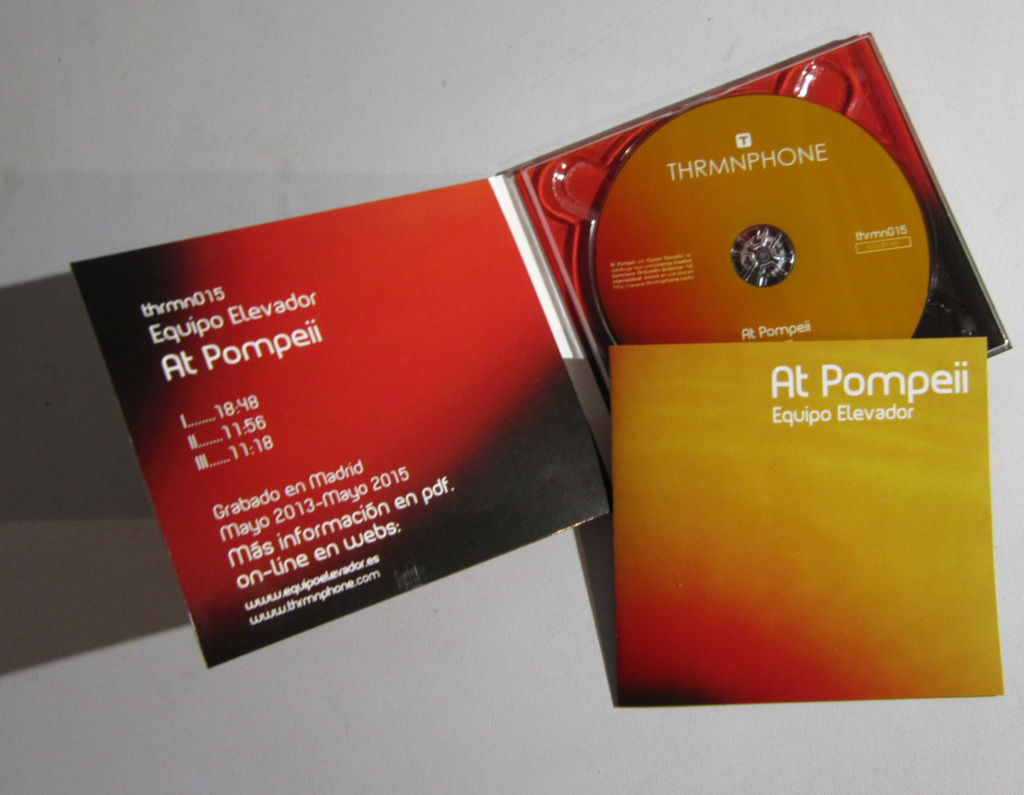
Una vez dada por finalizada la sesión, escucharon las tomas y a continuación el Equipo Elevador abandonó el estudio, de aquí a que me cruzara con el ellos otra vez pasarían años. Pero no por eso puedo eludir lo que, al menos, como testificador, viví. Mirando retrospectivamente, recuerdo la técnica de grabación, que como en ADD e incluso en sus primeros trabajos de 1999, fue realizada en un sistema analógico de cinta; esto prueba que el Equipo Elevador no estaba pensando en una nueva pieza, sino que querían grabar la última Intervención, o fue un titubeo, no sé. Todo lo ejecutado sobre el soporte magnético tuvo un proceso, primero digitalizaron el resultado, segundo limpiaron el ruido inherente de la cinta y tercero realizaron un trabajo de creación con la mezcla, resultando una obra en tres pasajes o movimientos. En este tercer proceso es donde se produce un cambio, podríamos decir que esta obra, está en el umbral de la ruptura. La mezcla se llevó a cabo en varias fases entre 2013, 2014 y 2015. Fue un desarrollo complejo, ya que cada fragmento de sonido tenía que cuadrar de tal forma que diese unidad musical. Los tres movimientos son denominados eléctricos, como si una corriente atravesara el oído sin piedad. En el primero y el tercero se aprecia claramente la construcción y las entradas y salidas de elementos sónicos, los dos, guardan cierta relación en cuanto a su forma, más estática y con más matices musicales. El segundo movimiento es dinámico y no tan complejo, puede recordarnos a propuestas anteriores, el uso del panorámico radical nos envuelve en una sensación rítmica diferente y hace de contraste con las otras piezas.
Aunque el contacto con el Equipo Elevador es nulo, me llega información, incluso poniendo todos los medios para evitarlo y así me he encontrado con una copia de At Pompeii en mis manos, con una imagen aparentemente indeterminada, observando y manipulando a la vez que escucho el disco, el trabajo gráfico, que está en sintonía con el musical, una desértica sensación de estar en el centro y en el extremo de cualquier cosa al mismo tiempo, parpadeando.
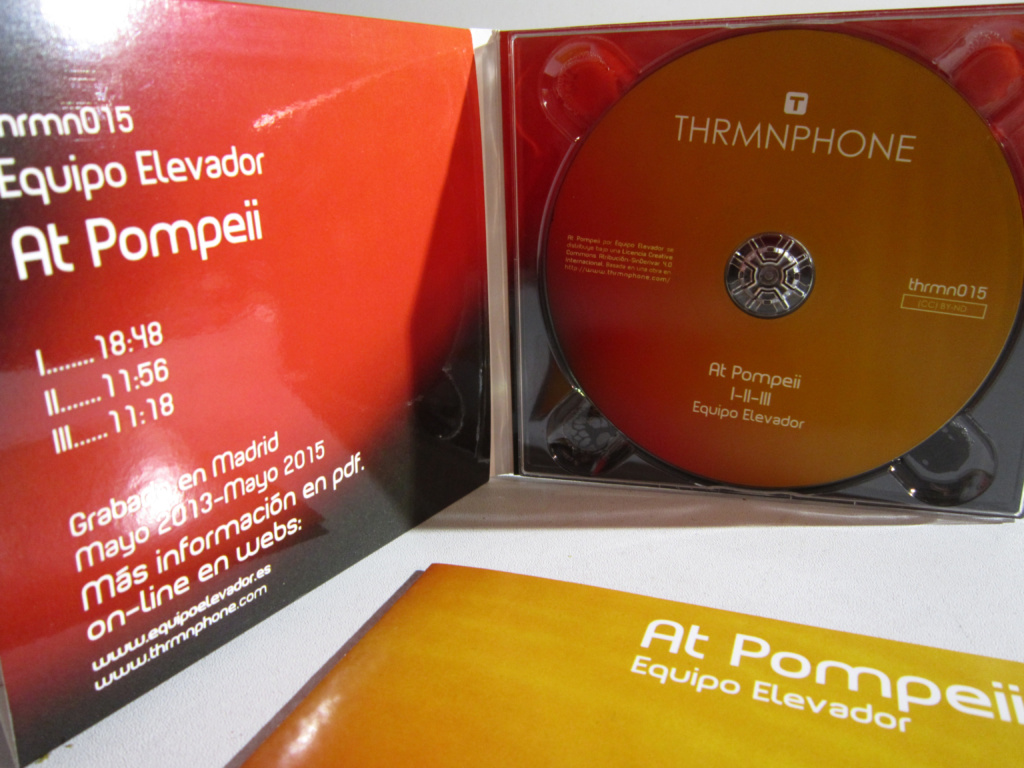
Durante esta aventura pompeyana, sé bien que el Equipo Elevador estuvo trabajando simultáneamente en otras composiciones, pero los caminos fueron otros, Maximum Electroacouistc (Alina 33) entre 2014 y 2016, obra enfocada a la puesta en vivo y Guthries en 2015 (no editada), fue un trabajo de música incidental para una obra de teatro, así como otras composiciones de tiempo más reducido para diferentes eventos y festivales (Pompeya-Cuenca-Lisboa de 2015, Electrocardiograma de 2013 a 2017 y …sin tiempo de 2014 a 2016).
La demora de la publicación de este trabajo que comento, inicialmente prevista para 2016, se ignoran las causas, quizá todo lo que ha estado rodeando al Equipo Elevador haya sido uno de los factores de tal retraso. Aun con eso, la obra no ha perdido ni la vigencia, ni la fuerza con la que fue concebida y ahora es tan buen momento como otro cualquiera para su edición. Tengan cuidado con el material, puede abrasar.
Ficha técnica:
Autor: Equipo Elevador
Editora: Thrmnphone
Referencia: Thrmn015
Formato: CD edición de 50 copias
Fotografías: Adriana Veyrat
Art work: Thrmnphone
Año: 2021
Disponible en: Thrmnphone

Equipo Elevador At Pompeii, an electrical work for fixed sounds by Emilio Babirusa
Translated by Elena B. Peláez
After the recording of this album, I stopped seeing Equipo Elevador for an indeterminate period of time. Having witnessed the elaboration of the project and the evolution of the Equipo itself, I have to go back to the work ADD (Modisti 13), with a line of work of quasi-improvisation that they had been experimenting with since roughly 2009. Other pieces such as Ranza in 2001 have a certain unintentional parallelism, and the occasional interesting live sessions under the name of Intervención, carried out regularly and with a view to starting points, continued with a disorientated pattern and without destination.
The music that plays in At Pompeii is the result of the work done for an Intervención, an intervention that took place on 19 May 2013 in the bookshop La Libre del Barrio in Leganés, Madrid. After weeks of sessions and periods of reflection, they constructed a piece that lasted 40 minutes, the average time of their live performance up to that date. This Intervención was recorded live with a mobile unit and delivered to Equipo Elevador; later in 2020 Thrmnphone, quite rightly, released the album LGNS2013, the live album, now out of print. The day after the Intevención, Equipo Elevador returned to the studio, this time to record the piece they had prepared and performed the day before, as they had never done any previous takes. For reasons unknown to all of us present at the time, the samples that were recorded in that morning session did not coincide at all with the initial intention. Possibly those long takes were exercises prior to the recording of the work, or it is possible that it was the next new work by Equipo Elevador… I opt for the evidence.
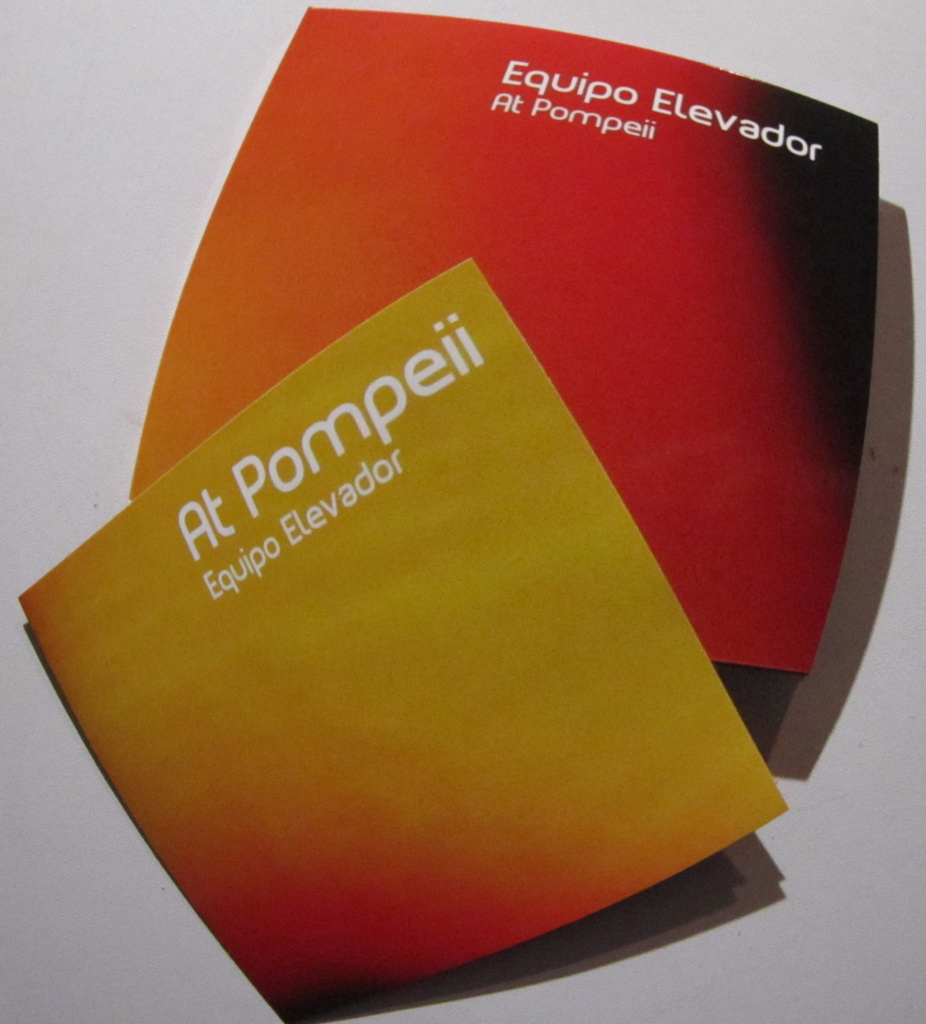
Those were not good political-social years, if ever, those sensations are manifested in the work of Equipo Elevador, but one can see the tendency towards aggressiveness and the extreme of that time, leaving behind the conceptual and complex works and their aspiration to reach an end, which was subtlety; But everything they were convinced they were working for collapsed and all that was left was to accept what they had or what they are, their obsessive sound and that now, in an introspective situation, the sounds of what was going to be At Pompeii, ended up being abrasive.
The recording was somewhat chaotic due to the technicians who had to set up the studio in a hurry after the live performance. I myself prepared the tape where the recording was to be made and wrote on the label «Secret Pompeii» (Fundación Autor 2010), a nod to that little midi music studio of Equipo Elevador in 2001, as a provisional title, but only a mistake can explain why that tape was not used but another one, labelled «At Pompeii«, which supposedly contained a master copy of «Pink Folyd At Pompeii«, by that rock band. According to the technicians, they still do not understand what happened, which is their responsibility. What is certain, however, is that this initial working name came to have its own autonomy of inspiration, beyond the relationships that can be established, such as the explosions and magma of Vesuvius in its day, with the sound of the Equipo Elevador.
 Design by Emilio Babirusa dismissed
Design by Emilio Babirusa dismissed
Once the session was over, they listened to the recordings and then the Equipo Elevador left the studio, and it would be years before I would meet them again. But that does not mean that I can avoid the experience I had, at least as a witness. Looking back, I remember the recording technique, which, as in ADD and even in their first works in 1999, was done on an analogue tape system; this proves that Equipo Elevador was not thinking about a new piece, but that they wanted to record the last Intervención, or it was a hesitation, I don’t know. Everything executed on the magnetic support had a process, first they digitised the result, second they cleaned the inherent noise of the tape and third they carried out a process of creation with the mix, resulting in a work in three passages or movements. In this third process is where a change takes place, we could say that this work is on the verge of rupture. The mixing was carried out in several phases between 2013, 2014 and 2015. It was a complex development, as each sound fragment had to fit together in such a way as to give musical unity. The three movements are called electric, as if a current is mercilessly running through the ear. In the first and third movements, the construction and the entrances and exits of sonic elements are clearly visible, both of which are related in form, more static and with more musical nuances. The second movement is dynamic and not so complex, it can remind us of previous proposals, the use of the radical panning envelops us in a different rhythmic sensation and contrasts with the other pieces.
Although contact with Equipo Elevador is non-existent, information reaches me, even if I make every effort to avoid it, and so I have found myself with a copy of At Pompeii in my hands, with a seemingly indeterminate image, observing and manipulating while listening to the record, the graphic work, which is in tune with the musical, a deserted sensation of being in the centre and on the edge of anything at the same time, flickering.

Thrmnphone Testing for Equipo Elevador At Pompeii
During this Pompeian adventure, I know well that Equipo Elevador was simultaneously working on other compositions, but the paths were other, Maximum Electroacouistc (Alina 33) between 2014 and 2016, a work focused on live performance and Guthries in 2015 (not edited), it was an incidental music work for a play, as well as other compositions of shorter time for different events and festivals (Pompeya-Cuenca-Lisboa from 2015, Electrocardiograma from 2013 to 2017 and …sin tiempo from 2014 to 2016).
The causes of the delay in the publication of this work, initially planned for 2016, are unknown, perhaps everything that has been surrounding Equipo Elevador has been one of the factors for such a delay. Even with that, the work has lost neither the validity nor the force with which it was conceived, and now is as good a time as any to publish it. Be careful with the material, it can burn.
Technical specifications:
Author: Equipo Elevador
Publisher: Thrmnphone
Ref: Thrmn015
Format: CD edition of 50 copies
Photographs: Adriana Veyrat
Art work: Thrmnphone
Year: 2021
Available at: Thrmnphone